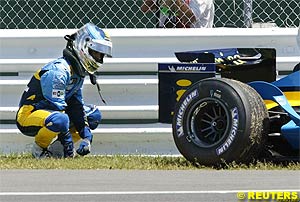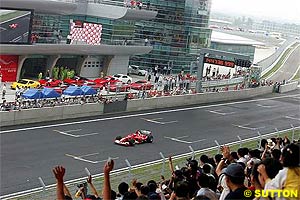Atlas F1 Magazine Writer
Fresh from the Formula One paddock
Think Renault R24, and you think blistering starts - whether by mop-topped Jarno Trulli or the French team's Spanish flyer Fernando Alonso. When the lights totally redden, all eyes are on the blue-yellow cars; when they extinguish, to be sure, the Renaults have made up three or four slots - assuming, in the first place, there were that many cars ahead of the entries from Enstone/Viry-Chatillon.
And, developing such devastating start systems is all for good reason: in this day and age, overtaking after the initial blast towards Turn One is well-nigh impossible, so it makes perfect sense to exploit those crucial first few seconds. And exploit them, through various trick bits, the Renaults do.
(The concept is not, in itself, novel - Gordon Murray's dart-like, turbocharged Brabham-BMW BT53 placed better than 70% of its weight behind the driver, and, as reviewing footage from those halcyon, 1400 bhp days attests, Nelson Piquet was one of that formula's quickest starters.)
But, weight distribution alone is not the key to Renault's jack-rabbit starts. Various theories as to the exact configuration of R24's traction control, which, in terms of the 2004 regulations, is legal above speeds of 100 km/h. Some believe a particularly 'soft' clutch allows certain slippage; others that a gradually retarding ignition map, as opposed to the brutality of cutting sparks, does the trick gently; still others that the engine has been designed for torque (= acceleration) rather than revolutions (= outright speed). Finally, there is a faction that points to the fact that Renault's sweet chassis generally allows one grade softer rubber to be used, thus providing additional advantage over its Michelin-shod rivals.
Maybe, then, a combination of all four factors, for none are mutually exclusive?
But, now comes the tricky bit. Unheard by most observers in the pre-start cacophony, Renault's drivers rev the V10s to their absolute limits, then allow the clutches to bite. At the exact point of transition from stationary to movement, electronics remember the revs and 'bite point', then maintain that level. The driver keeps right foot down; plants left boot heftily on brake pedal and lifts at the 'Off'. Voila, and all legal, for it is driver activated and controlled. But, as Jarno Trulli admitted in Monaco, the starts are "30% driver and 70% technology". Up to the regulatory 100km/h, that is when, electronics take over after second gear has been selected.
Imagine, though, the violent stresses and vicious strains placed upon engine and transmission, factor in the incredible heat and harsh vibrations torturing through the vehicle during those ten or so pre-start seconds as over 800 horsepower are simultaneously unleashed and brutally restrained. To survive, clutches and driven plates are massively reinforced, transmission shafts and gears beefed up beyond normal F1 standards of durability (but, again, these additional weights aid traction), rear suspension cross-braced to maintain geometry, and driveshafts and their joints strengthened.
And still, as Trulli's Canadian non-start showed and Alonso's lap 45 retirement, the latter design is still incapable of transmitting these pre-start forces reliably. Of course, it is possible, nay, logical, that Renault specified particularly high (high torque = low speed) primary and secondary gear sets to enable vital acceleration during the short post-start burst to Turn One, and to provide slingshot grunt out of Montreal's extreme hairpins. Those ratios would, beyond doubt, have increased the forces, with increased probability of failures.
And, therein lies the rub. Indianapolis, like Montreal, has a short burst of speed to a sharp Turn One, and fits various stop-go fiddly bits into its infield. Worse, from Alonso's retirement on Sunday to the first turn of his wheels on Friday leaves the team less than six days to design, manufacture and rig-test replacement shafts - if those huge pre-start forces can be at all accurately replicated. The team, of course, may elect to run the permitted pre-Grand Prix total of 50 'shakedown' kilometres on both cars somewhere in the US, but the FIA regulations in this regard are, at best, hazy.
They ban testing on circuits outside of Europe, whilst the wording of Clause 63 a) of the 2004 Sporting Regulations specifically prohibits testing on non-approved tracks: "No testing is permitted at sites which are not currently approved for use by Formula One cars". Then, testing at Grand Prix venues is outlawed, unless specifically permitted, so a 'quickie' at Indy, on say, Wednesday, is out.
Are simulated starts - of which plenty, using both cars, can be run in 50 kilometres - 'shakedowns'? Are airport runways, ideal for these purposes, categorized 'test circuits', and, thus, requiring approval? Will Renault stick to their existing driveshaft design, at least until they return to Europe, and simply instruct their drivers to go easy at the start, and forego the substantial advantage they have carved for themselves? Or were the double-retirements in Canada simply down to "bad luck" as Alonso said?
The best indicator is to track the movement of Renault's cars prior to Friday practice.
With a Chinese Grand Prix scheduled for September, and with Chinese driver (albeit domiciled and educated in Holland) Ho-Pin Tung having tested for Williams, what chance a Chinese Formula One team before too long?
Already there is talk that Asia's largest oil company, Sinopec - already confirmed as title sponsor of Shanghai's Grand Prix - is about to do long-term sponsorship deal with a prominent team, with other companies sure to follow as the country latches on to the promotional advantages and technical opportunities offered by the sport.
But, sponsorships and partnerships are one thing; team management a completely different kettle of fish.
Initially said to be looking at acquiring cars and engines from an existing team in line with FIA President Max Mosley's objectives, the former McLaren and Ferrari driver, who scored a pole position for Ferrari at the 1985 German Grand Prix and took 12 podiums in a 79-race F1 career, hopes to gradually convert the team into a chassis manufacturing operation.
A source suggests that the team could be up and running at the first round next year should the FIA drop its requirement for the $48m bond. Tyres should not present a problem, either: "Bridgestone would have to supply the team if asked to do so," he added. That would tend to indicate chassis and engine procurement from a present Bridgestone-supported team. What price two yellow Ferrari in Melbourne next year? There is, of course, a precedent: shortly before Malaysia joined the calendar, the Asian country's national oil company joined forces with Sauber, initially as sponsor and later as engine partner developing second-hand Ferrari units. And, on Melbourne's grid this year, there were, swears half the paddock, two half-used Ferraris painted a particularly Malaysian shade of blue.
Could Ferrari supply two teams in 2005? Well, the Gestione Sportiva's customer department has just been substantially enlarged...

 Relying upon fundamentally antiquated engine architecture - Renault is, for example, the only manufacturer team to run a 72° V10 - which is both top-heavy and robust, the design offsets its mass disadvantage, and, therefore, theoretical performance deficit, by biasing the additional weight rearwards to aid launch traction, particularly now that starts through gizmo-assistance have been outlawed.
Relying upon fundamentally antiquated engine architecture - Renault is, for example, the only manufacturer team to run a 72° V10 - which is both top-heavy and robust, the design offsets its mass disadvantage, and, therefore, theoretical performance deficit, by biasing the additional weight rearwards to aid launch traction, particularly now that starts through gizmo-assistance have been outlawed.

 Now, though, comes news that the entrepreneurial former F1 driver Stefan Johansson (47), in conjunction with various Chinese government departments and companies, is planning on assembling F1's 11th team, thus beating Arden, Carlin and Super Nova to the honours. It is said that the Swede, already well-versed in team management via ALMS, Le Mans and CART exploits, has retained a Hong Kong-based PR and marketing company to acquire the technical and financial support such a venture would require.
Now, though, comes news that the entrepreneurial former F1 driver Stefan Johansson (47), in conjunction with various Chinese government departments and companies, is planning on assembling F1's 11th team, thus beating Arden, Carlin and Super Nova to the honours. It is said that the Swede, already well-versed in team management via ALMS, Le Mans and CART exploits, has retained a Hong Kong-based PR and marketing company to acquire the technical and financial support such a venture would require.
|
Contact the Author Contact the Editor |
Please Contact Us for permission to republish this or any other material from Atlas F1.
|
Volume 10, Issue 24
Atlas F1 Exclusive
A Weekend with Timo Glock
Bjorn Wirdheim: Going Places
Ann Bradshaw: Point of View
2004 Canadian GP Review
2004 Canadian GP Review
Just Enough
2004 US GP Preview
2004 US Grand Prix Preview
US GP Facts & Stats
Stats Center
Qualifying Differentials
SuperStats
Charts Center
Columns
Season Strokes
Rear View Mirror
Elsewhere in Racing
The Weekly Grapevine
> Homepage |
